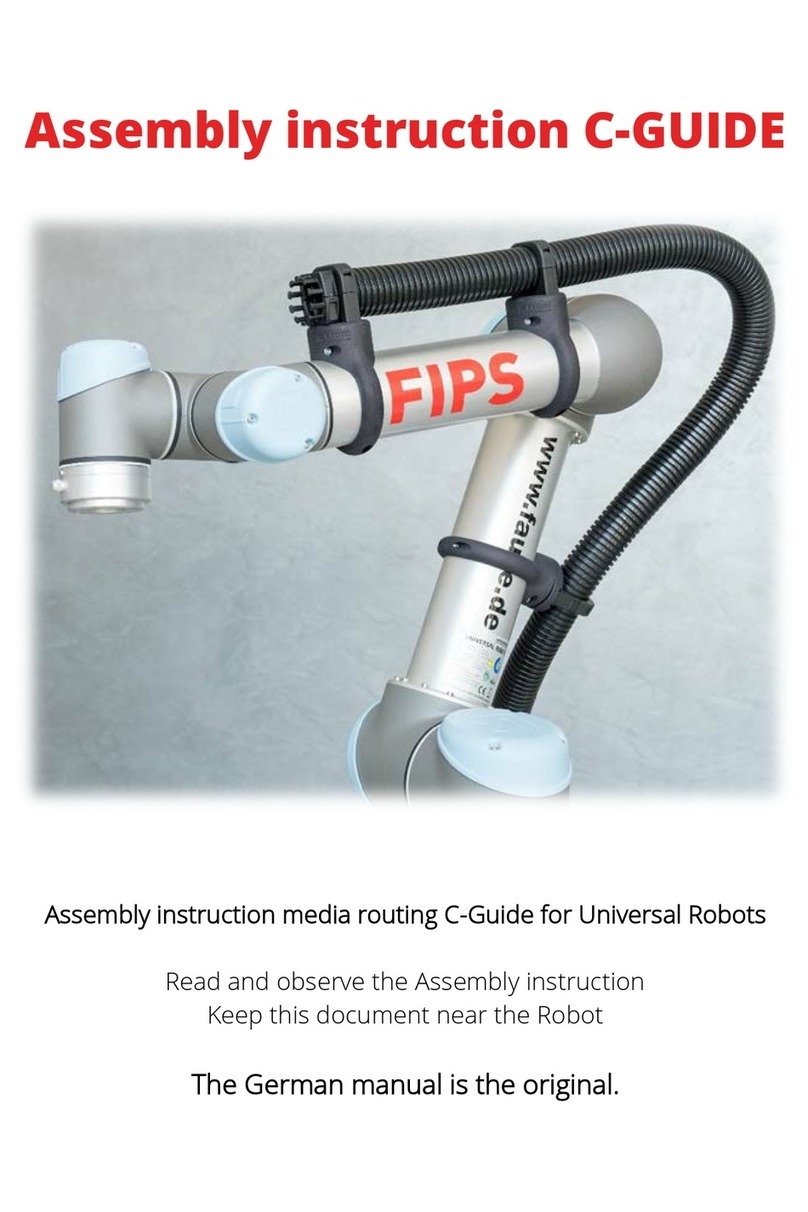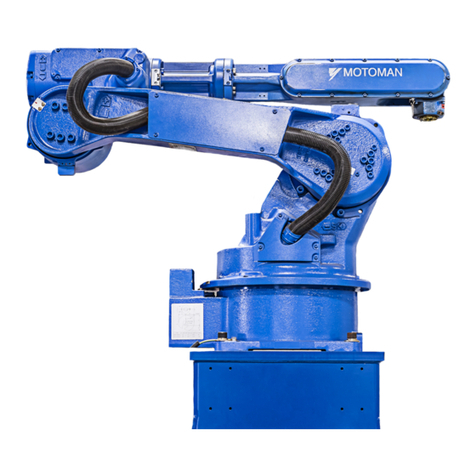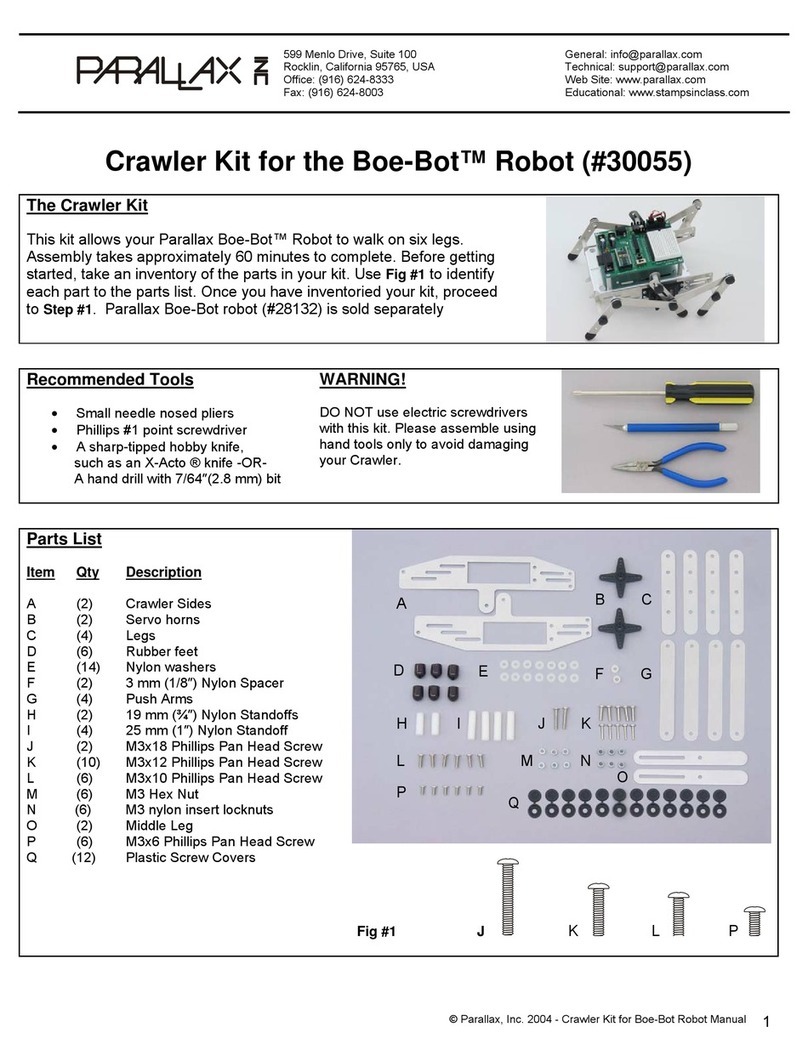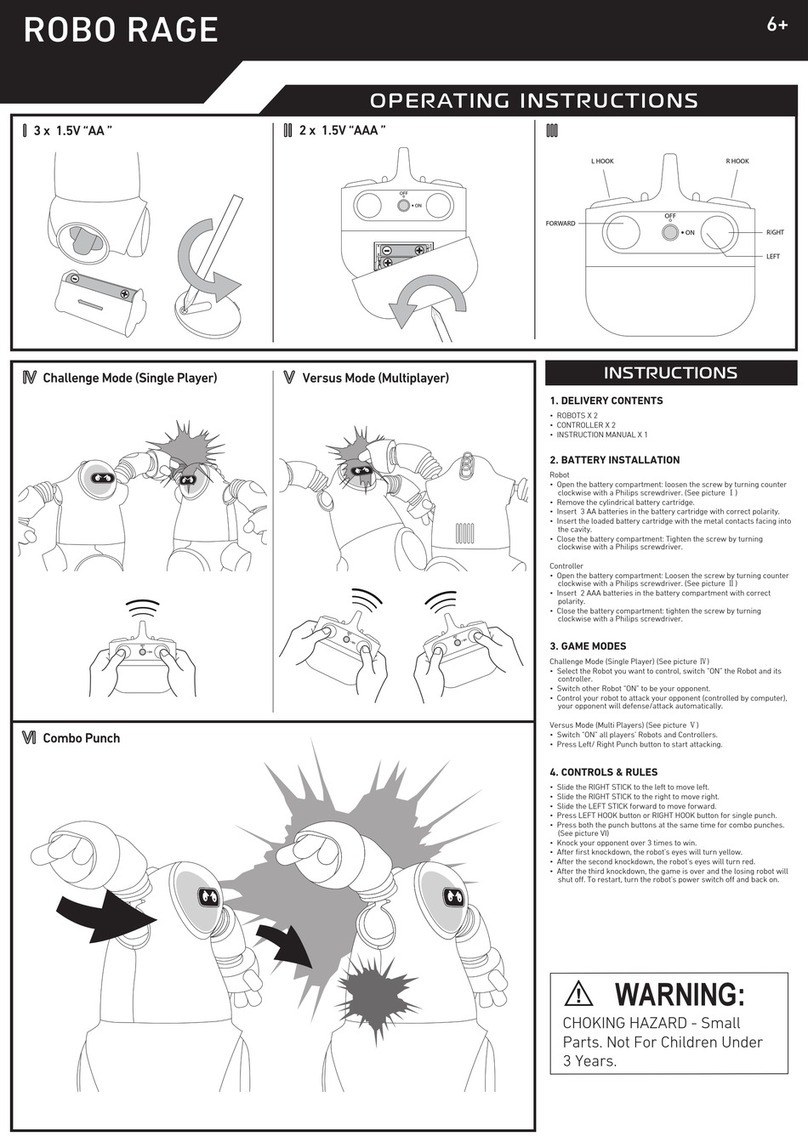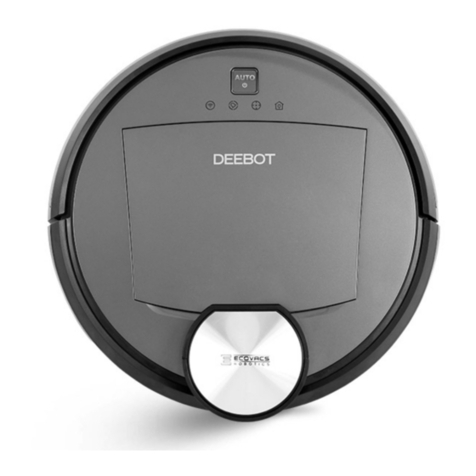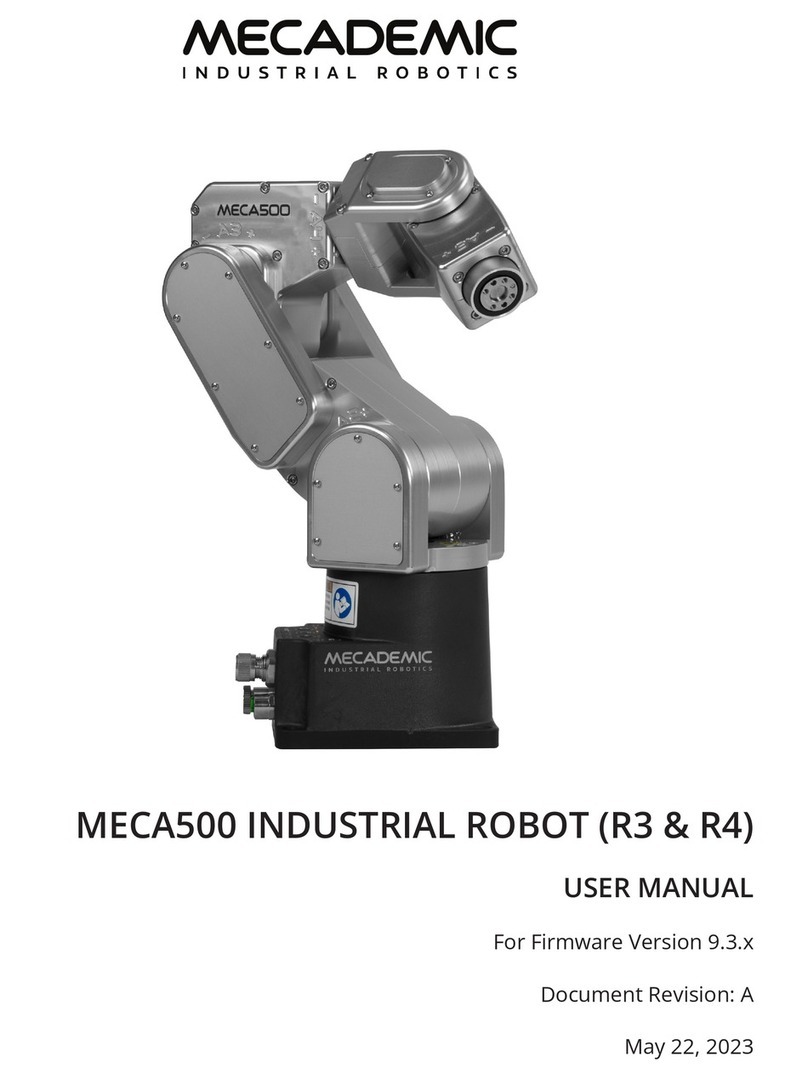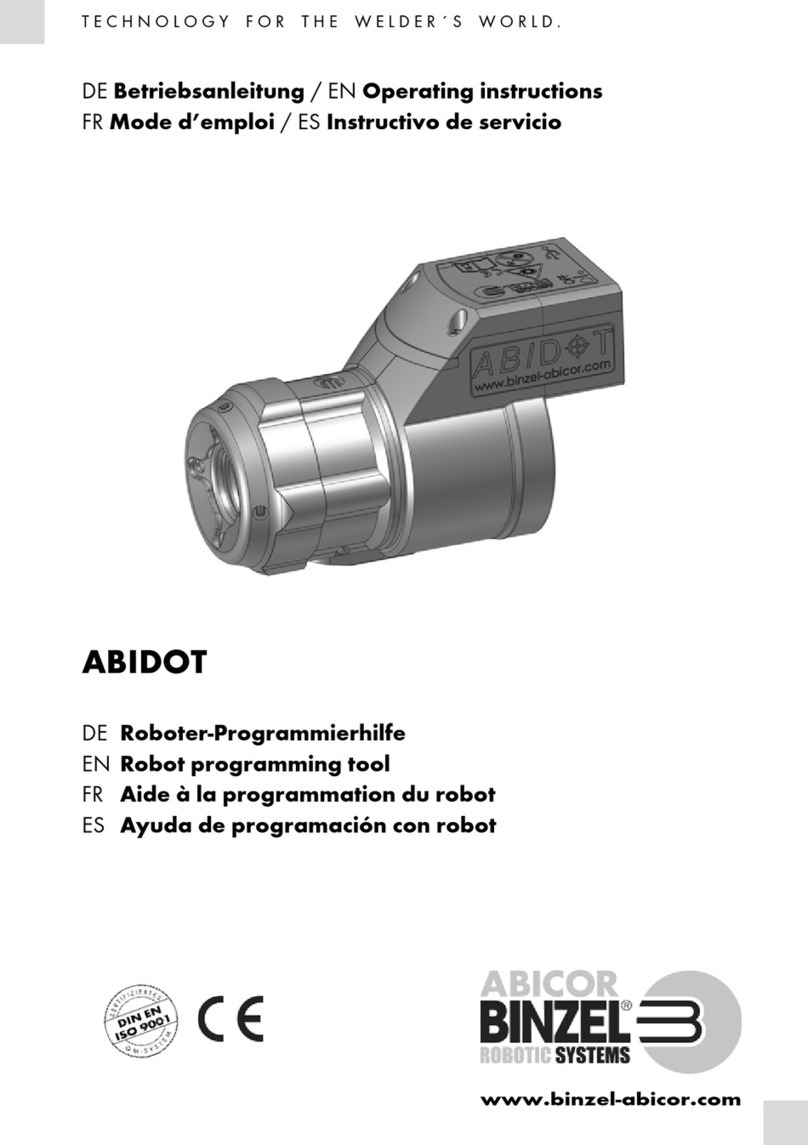ROSCAMAT 9001 NC User manual

OPERATOR’S MANUAL
ROSCAMAT-9001 NC
TECNOSPIRO, S.A.
Polígon Industrial Pla dels Vinyats, nau 2 – 08250 Sant Joan de Vilatorrada(Barcelona) Spain
«+34 93 8764242 / +34 93 8764359 ¬+34 93 8767738/4044
Model Serial nr. Machine nr. Year of manufacture

2
CHAPTER 1 – INDEX
Page no.
Chapter 0 Introduction ................................................................................ 3
Chapter 1 Description R-9001 NC ....................................................... 4
Description R-9001 NC C33............................................. 5
Description: Tool lubrication / Lifter............................ 6
Modular system 7
Chapter 2 Installation – Set up ............................................................ 8
Operation
Chapter 3 NC operation ............................................................................ 9
Displaydescription 9
Configuration: Thread direction ................................. 9
Module activation – Depth……. 10
Lubrication …......................................... 11
Language – Activate Threads …. 12
Manual operation
……............................................................... 13
Automatic operation ................................................................. 14
Menus structure
........................................................................ 15
Chapter 4 Warnings ..................................................................................... 16
Chapter 5 Trouble shooting ....................................................................... 17
Guarantee
..................................................................................... 18
Chapter 6 Maintenance –Repairs
Damper substitution.................................................................. 19
Key substitution (display)
...................................................... 19
Trigger substitution ................................................................... 19
Micros substitution .................................................................... 20
Motor grip substitution ............................................................ 20
Motor substitution ...................................................................... 20
Fuse substitution ....................................................................... 21
Fan substitution .......................................................................... 21
Lubrication pump substitution ............................................ 21
Display plate substitution ...................................................... 21
Variator plate substitution ..................................................... 22
Chapter 7 Spare parts list ........................................................................... 23
Chapter 8 Range of standard products ............................................... 26
Chapter 9 Annexe
Working areas ROSCAMAT 9001 NC ........................... 29
Working areas ROSCAMAT 9001 NC C33................. 30
Connections .................................................................................. 31
Machine Section ......................................................................... 35
Technical data – motor characteristics .......................... 37
Technical data – torque .......................................................... 38
Notes ................................................................................................. 39

3
CHAPTER 1 – INTRODUCTION
Dear customer:
We wish to take this opportunity to thank you for choosing a “ROSCAMAT” tapping machine
to produce quality threads and associated operations.
This operation’s manual is given to you so that by careful reading of its content, it will enable
you to maintain its reliability and performance for long-life.

4
CHAPTER 1 – DESCRIPTION ROSCAMAT-9001 NC
1. Machine base
2. Lifter case
3. Electric cable
4. Electric current main switch
5. Electronic box casing
6. Oil reservoir filling cap
7. Handle turning brake
8. Damper regulation handwheel
9. “Trigger” - motor starting button
10. Motor
11. Motor head
12. Module
13. Articulated pipe (tool lubrication system)
14. Tilting arm
15. Cross unit
16. Union
17. Radial arm / Oil deposit drain cap
18. Arm enclave
19. Display screen
20. Key board
The machine consists of a pendular parallelogram that is balanced by a pneumatic spring,
plus a radial arm. The gas spring and the radial arm assembly fix the motor head and keep it
perpendicular to the working area.
The electronic motor is equipped with a NC control. The machine can work in either manual
or automatic mode, allowing us to configurate and control aspects such as the thread depth,
the desired quantity of lubrication for each tap, the material type or else the recommended
thread speed. By means of a quick-change system, a set of 6 modules or reducers can be
assembled to the motor end. These allow us to adjust the thread speed depending on the
size to be done.
Aforesaid modules have also incorporated a quick-change system to fit the tapholders with or
without safety clutch.

5
CHAPTER 1 – DESCRIPTION MACHINE ROSCAMAT-9001 NC C33
The ROSCAMAT-9000 NC C33 is supplied with an articulated head of easy handling which
allows us to positionate the motor in vertical or horizontal position.
♦Orientable headmember
1.-Horizontal turn clamp handle
2.-Head orientation clamp handle
3.-Feeler of perpendicularity (to be used in horizontal threads)
4.- Regulation handwheel of feeler length
Note: loosen it and remove the feeler-rod assembly if needed
Vertical operations
♦Place the motor in vertical position, and lock handles 1 and 2.
Horizontal operations (Max. M27):
♦Loosen handle 2 to unlock the joint of the motor
♦Turn the head 90º till you reach its interlock, and
tighten the handle again (2).
♦Unlock handle no.1 located in the upper side of the
headmember.
♦Align the feeler with the piece to be threaded and
proceed with the thread always keeping the feeler
correctly aligned to the piece.
•Do not lock the handle 1 in horizontal operations !
•Maximum thread in horizontal : M27
•Maximum module in horizontal: mod. 75 ( module 40 cannot be used
in horizontal operations)

6
CHAPTER 1 – DESCRIPTION
AUTOMATIC TAP LUBRICATION
*Caution: USE CUTTING OIL.Certain lubricant types containing trichlorines and alcohols
can damage some of the valve components..
Inside the radial arm (no.6 page 4) the cutting oil reservoir is located. This is used for
lubricating the tool during the tapping operation.
The lubrication time is predetermined in the NC programme according to the size of tap.
However by means of the screen keys, we can vary the lubrication time percentage
depending on the material, the tap condition, etc. For its programming, please check pages
11, 13 and 14 if you work in manual as well as in automatic type.
After filling up the oil reservoir because of being empty, it is possible that there is air inside its
system so that you must switch on several times the motor until the circuit is completely
bleed.
LIFTER
We can increase the working area in 170 mm in order to work on different height levels. For
doing this, we should:
To adjust the desired height level position of the
machine, you must close up the arms by placing
the tilting arm in its interlock (18, page 4) and
apply some pressure up or down until reach the
needed height
The lifter system remains blocked when opening
out the arm.

7
CHAPTER 1 – DESCRIPTION
MODULAR SYSTEM - CHARACTERISTICS
Driven from a single motor, six different speed modules are available with their
relevant power torques.
The six quick-change modules provide the speed and torque for each threading type,
from M3 to M36 threads (M42 in aluminium), getting this way a high saving in time
and energy
MAXIMUM THREADS
Module Reducc. Max.
speed.
(rpm)
Torque
max.
(Nm)
Coupl
∅. Aluminium
100 HB Grey
foundry
GG22
Steel
<90Kg Steel
90-115 Kg. Steel
>115Kg.
40 35 40 340
∅48 M42 M39 M36 M33 M27
75 18,85 75 185
∅31 (M33) M30 M27 M27 M22
140 9,7 140 95
∅31 M27 M24 M22 M22 M16
320 4,5 310 44
∅19 (M20) M16 M16 M16 M12
500 2,91 480 28 ∅19 M16 M12 M12 M12 M8
900 1,54 900 15 ∅19 M10 M8 M8 M6 M6
Motor 4500 3
Headmember 3,25 1385 9,75
(-) For the sizes in brackets, we should dress the tap shank dimens. (ø) and the driving cube
()(to fit the tapholder’s size) or order a special module with the upper type coupling
diameter.
In manual operation, it is advisable to lower the cutting speed to 75% if the operator is
working with modules 40, 75 and 140 in threads which are close to their maximum capacities
in hard steels.

8
CHAPTER 2 – INSTALLATION, SET UP
INSTALLATION
A: Fix the base of the machine to the working table by means of four M8 screws or the
clamp.
B: Fit the machine into the base plate shaft, and firmly tighten the M12 threaded rod with a
6 mm. ALLEN wrench (nr.4, pag.35)
C: Raise the lifter cover (2, pag.4) and fix it to the machine by means of 2 ALLEN screws
(nr. 39, pag.35)
D Connect the machine to a single-phase socket (220 V supply), and switch it on.
E: Arm balance
By turning the damper regulating handwheel (8, page 4) to the right (-) or to the left (+)
different weights at the arm end are balanced.
Move this handwheel with the arm in horizontal position or lightly raised.
IMPORTANT:
•Make the connection to a single phase socket ( 220 V.)
•The socket must have a ground wire and differential of 300 mA..
•Machine power: 1400 W
OPERATION
Manual mode: Select the most suitable module according to the size to be threaded.(see
page 7)
♦Turn the slide collar (2) to the left, insert the module, and
turn the slide collar to the right. Regulate the arm balance
according to the weight of the module to be hold, specially
when fitting modules 40, 75, & 140.
♦Insert the tapholder into the module (3).
The motor starting button –trigger- (1) has two positions:
♦To thread, push the starting button-trigger (1) up to its middle
position.
♦To unthread, push the starting button up to its final position
♦To change the tap, pull up the module slide collar (3) and the
tapholder will come out automatically.
Automatic mode: Insert the module and the tapholder advised by the NC control, and
proceed following the above mentioned instructions.

9
CHAPTER 3 – NC OPERATION
+
BOARD DESCRIPTION
Cursor key: to
select among
different options
Validation key
To increase or
decrease the
value within
the several
options.
Go back to the main menu
3.1 MENU CONFIGURATION
By choosing the aforesaid option, the following screen appears:
Select the desired option by using the cursor and the validation keys.
3.1.1 Thread direction
This option allows us to configurate the machine to make right or left hand threads.
Entering the menu, the following screen appears:
To change between one or the other direction, key: or
Once the thread direction has been selected, key to go back to the configuration
menu.
-
OK
CONFIGURATE _
THREAD DIRECTION
ACTIVATE MODULES
DEPTH
LUBRICATION
LANGUAGE
ACTIVATE THREADS
Thread direction
Right

10
CHAPTER 3 – NC OPERATION
+
3.1.2 How to activate modules
This configuration is valid to work in the automatic mode, into the “configuration”
menu, you must activate the modules you have .
Once this option is selected, the screen will show the following:
The modules that can be used are: 40 – 75 – 140 – 320 – 500 - 900. The modules you
have, must be activated. The ones that you do not have must be deactivated.
When the most suitable module is not activated, the automatic mode, by means of the
control, will suggest the immediately inferior (slower) module with the appropriate
thread capacity.
To activate the modules, use cursor keys or to chose the desired
one and use the keys to change between activated and deactivated.
Once the suitable option has been selected, key to go back to the
configuration menu.
3.1.3 Depth
You can control the depth of the thread in milimetres or inches. The machine control
depth only works when choosing automatic type.
To select the units by which you want to control the depth, use keys: or
and once the suitable option is selected, press to go back to the
configuration menu.
___ACTIVATE MODULES___
900 ACTIVATED
500 ACTIVATED
320 ACTIVATED
140 ACTIVATED
75 ACTIVATED
40 ACTIVATED
OK
----___DEPTH---___
Milimetres
Inches
OK
-

11
CHAPTER 3 – NC OPERATION
+
3.1.4 Tool Lubrication
By selecting this option, the following screen appears:
The tool lubrication time is predetermined by the programme depending on the thread
dimension to work. Nevertheless, if needed by the working conditions, you can change
the lubrication percentage in between 0% and 200% over the calculated time and in
intervals of 5%.
To change the aforesaid value in intervals of 5 % press the keys and
once the suitable value has been selected, key to go back to the
configuration menu.
The standard lubrication time (in seconds) is determined by the formula:
25
diameter
time =
LUBRICATION
100 %
OK
-

12
CHAPTER 3 – NC OPERATION
+
3.1.5 Language
Configurate the desired language by which you wish to read all the menus’ of the
machine by pushing on the written LANGUAGE letters:
Move through the screen by using the keys or and confirm the
language by pressing
3.1.6. Activate Threads (thread type, Metric, Whitworth, Gas, NPT, etc)
The control contains introduced several thread types with their correspondent
normalised pitch which after being activated into the configuration menu, can be
choosen to work only in automatic way.
Once this option is selected, the screen will show the following:
To select the kind of thread you want the menus to appear, use keys: or
and activate or deactivate the type of thread that you most use by the keys
Once the suitable option is selected, press to go back to the configuration menu.
----_ACTIVATE THREADS__
Metric
Whitworth
Gas
UNC
NPT
NPS
OK
LANGUAGE
Catala
Castellano
English
French
Deutch
Italiano
Portuguese
Nederland
OK
-

13
CHAPTER 3 – NC OPERATION
+
3.2. MANUAL RUNNING
Place the cursor on the option MANUAL, key and the following screen will be
shown:
In the manual mode it is only possible to configurate the speed percentage to each direction
according to the chosen module and the lubrication time.
If you want to work without the tool lubrication, its value must be 0. If it should not be so, the
time (seconds) of lubrication needed has to be informed by using the keys
The counter indicates the number of threads done during the manual running. This value is
accumulative, even after a machine disconnection. To put its value to 0, key having
the cursor on the counter’s value.
Once the manual running option is configurated, the machine is ready to work. To work on
the aforementioned option, it is only necessary to push the trigger. Its whole run is separated
in two sections; the first one to thread and the second, by pushing the trigger up to the end,
to unthread (see page 7)
To go back to the main menu key
______MANUAL______
speed to right 70 %
speed to left 100 %
lubrication 0.4
counter 0
OK
ESC
OK
-

14
CHAPTER 3 – NC OPERATION
OK
+
+
3.3 AUTOMATIC RUNNING
When choosing this option, the following screen appears:
To move along the assorted screen options, key or
In the mode of automatic running the kind of thread : METRIC, WHITWORTH, GAS, UNC,
NPT or NPS can be chosen.
To choose among them, place the cursor on the thread size and key until the
desired system appears.
Once the type of thread is selected, enter the thread size and the material to be threaded, by
means of and keys. The control will then configurate the rest of
parameters (pitch, time of lubrication) and advises the most suitable module to be used.
The programme allows to configurate separately each element by placing the cursor on
them. This is very helpful in cases such as thin threads or threaded holes overhaul.
Thread depth control:
Place the cursor key on the depth dimension, and choose the desired one by using keys
or . The measurement can be expressed in inches or millimetres by
configurating it into the menu configuration, Depth.
If the thread depth is different to 0, it is only necessary to push the trigger up to the first
position and the machine will automatically reverse the movement once the desired depth is
reached, whereas if no thread depth is selected, the operator will have to push the trigger up
to the end to unthread.
ATTENTION: When working with a depth different to 0, the module fitted
in the machine must coincide with the one shown on the screen. The
thread pitch must also be the same as the one in the screen.
The lubrication and the counter are operated as in the manual configuration.
To go back to the main menu, press
____AUTOMATIC____
METRIC 36.0 x4.00
Depth 12mm
material Alluminium
module 40 rpm 40
lubrication 1.4
counter 0
ESC
-
-

15
CHAPTER 3 – NC OPERATION
9001 N
C
Manual S
p
eed ri
g
ht
(
from 10% u
p
to 100%
)
S
p
eed left
(
from 10% u
p
to 100%
)
Lubrication
(
from 0
,
00 u
p
to 3
,
00 sec.
)
Counter
Automatic Metric Metric
(
from M3X0
,
5-M42X4
,
5
)
Whitworth
(
from 1
,
8"X40-1"1/2"X6
)
Gas
(
from1/8"x28 u
p
to 1"1/4"x11
)
UN
C
NPT
R
C
NPS
De
p
th mm
(
from 0 u
p
to 99 mm
)
inches
(
from 0" u
p
to 2 1/2"
)
Material Steel>115 K
g
.
Steel 90-115 k
g
.
Steel 60-90 k
g
.
Steel<60 k
g
.
Bronze>40 K
g
.
Bronze<40 k
g
.
Foundr
y
Aluminium
Plastic
Module 900 r
p
m
500 r
p
m
320 r
p
m
140 r
p
m
75 r
p
m
40 r
p
m
Lubrication
(
From 0
,
00-3
,
00 sec.
)
Counter
Confi
g
uration Thread direction
Activate Modules 900 Activated / Deactivated
500 Activated / Deactivated
320 Activated / Deactivated
140 Activated / Deactivated
75 Activated / Deactivated
40 Activated / Deactivated
De
p
th Milimetres / Inches
Lubrication
(
From 0 u
p
to 200 %
)
Lan
g
ua
g
e Catalan
S
p
anish
En
g
lish
French
Deutch
Italian
Portu
g
uese
Nederlands
Activate Threads Metric Activated / Deactivated
Whitworth Activated / Deactivated
Gas Activated / Deactivated
UN
C
Activated / Deactivated
NPT Activated / Deactivated
R
C
Activated / Deactivated
NPS Activated / Deactivated
Left / Right

16
CHAPTER 4 – WARNINGS
The usage and running of the machine has several risks and some preventive measures
should be taken into account by the operator to avoid any physical damages.
1.- Use always security glasses when working with the machine
2.- Do not put the fingers near the headmember end when the arm reaches its higher
position.
3.- When changing the modules 40, 75 or 140, place the arm in its higher position in
order to avoid a sudden movement upwards when taking out the module from its
placement. This hit would come due to the energy accumulated by the damper.
Before making any manipulation to the machine, for verification, manipulation, repair or
maintenance, the following aspect should be bore into account:
4.- Disconnect the machine from the power supply, before taking out the board cover or
the motor case.

17
CHAPTER 5 – TROUBLE SHOOTING
PROBLEM: THE MACHINE FAILS TO OPERATE, THE MOTOR DOES NOT START OR STOPS
Remove the electronics box housing (5, page 4) thereby exposing the electronics, and check
the trouble condition as per the LED’s being provided on the board’s back side.
With the machine and the main switch on:
- The green LED –POWER- must be always on. This is an indication that the speed
electronics board is operative.
- Green LED off.Check the voltage input and the fuses.
- If the LED's L1, L2, L3 are not on with the motor running, this is indicative of the
correct operation of the unit.
- If any of these LED's is on, troubleshoot as per the following table:
LED’s
Green L3 L2 L1 TROUBLE NOTE
●●
INHIBIDO Proper operation of the machine. This LED L3 goes off
when starting the motor
●●
Temp. Motor (ºC.) Very high temperature. Wait till the motor temperature
lowers and reset the unit.
●●●Def. Power Short-circuit between the motor phases or in the power
stage. Reset the unit and contact the manufacturer if the
problem persists.
●●Over Voltaje Overvoltage. Check the voltage input
●●●Under Voltaje Low input or power level. Check the voltage input.
●●●l2t ciclo alto High current consumption (effective current) due to an
overload while in operation. Reset the unit.
●●●●Error resolver
Sensor trouble because of a cut or wrongly connected
cable or because of a wrong configuration of the
variator.
1.- Check the cables between the variator and the motor.
2.- Reset the unit and contact the manufacturer if the
problem persists.
PROBLEM: THE TILTING ARM DROPS
Probable reasons Solution
1.-Not-equilibrated arm = Balance the arm according to the weight to
be held. Verify point E (page 8)
2.-Defective damper = Replace it for a new one (page 19)

18
CHAPTER 5 – TROUBLE SHOOTING
PROBLEM: THE CLUTCH SLIPS AND THE TAP CANNOT BE TURNED, BEING THE
MOTOR IN OPERATION
Probable reasons Solution
1.- Clutch slackness = Adjust clutch (page 18)
2.- No tool lubrication = Use cutting oil or with additives according
to the material
3.- Inappropriate tap for the material = See page 39
4.- Tap spoiled “worn”
5.- Misaligned hole
6.- Drilled hole diameter too small
PROBLEM: THE LUBRICATION SYSTEM DOES NOT WORK
Probable reasons Solution
1.- Oil reservoir empty = Fill in the reservoir (filling cup 6, page 4)
2.- Lubrication nipple obstructed = Unscrew the end of the lubrication nipple
and clean it. (ATTENTION: Do not mislay the
spring and the ball located inside)
IMPORTANT:
If the oil reservoir has been fully emptied the circuit will have possibly been filled with air, so
that after having filled the reservoir it is necessary to start the motor several times in
succession with the lubrication time set to the maximum.
WARRANTY
The warranty period for the machine is 12 months. The warranty does not cover any damage
caused by overloads, wear and improper handling of the machine. The warranty covers the
costs of labouring and damaged spare parts. The transport, packaging and assurances are
at customers’ costs.
CLUTCH ADJUSTEMENT
Remove the small spring clip around perimeter and turn the notched nut clockwise or
counterclockwise to increase or decrease the clutch tension and put the small ring back onto
the new notch.

19
CHAPTER 6 – MAINTENANCE, REPAIRS
DAMPER SUBSTITUTION R-9001 NC Ref. 91100704
R-9001 NC C33 Ref.917A0204
1. Disconnect the main switch
2. Take out the plastic cap located in the arm’s upper part.
3. Move the arm up to its higher position
4. Turn to left the regulating handwheel to the maximum
ATTENTION: always keep the arm in its higher position!
5. Remove the plastic cover located between the cross unit and the tilting arm
6. Take out the M5 Allen screw that is at the end of the regulating screw rod.
7. Turn the regulating handwheel leftwards until the arm has no tension in the damper.
8. With the help of a M5 screw, take out the pin from the fork.
9. Remove the damper pin in the arm
10. Turn to left the regulating handwheel until the fork is free from the screw rod
11. Take the damper-fork assembly out and replace the damper.
*For the assembling, proceed the other way round, paying attention to the damper position
inside the pin notch in the arm.
KEY-BOARD SUBSTITUTION Ref.EL010126
1. Disconnect the main switch
2. Take the keyboard out by putting a small screwdriver between the keyboard and the
frame of the motor case (small gap on its upper part).
3. Disconnect the connector
4. Connect the connector to the new display
5.- Put 4 points of silicone in the motor case border and place the display properly.
STARTING BUTTON SUBSTITUTION; TRIGGER Ref.90103703
1. Disconnect the main switch
2. Unscrew the 4 sheet screws and the 2 Allen screws in the motor grip right side, and
remove it.
3. Take the grip clamp out
PAY ATTENTION to balls and springs
*For the assembling, please proceed the other way round paying special attention to the
balls and springs position.

20
CHAPTER 6 – MAINTENANCE, REPAIRS
MICRO’S SUBSTITUTION Ref. EL010066
1. Disconnect the main switch
2. Unscrew the 4 sheet screws and the 2 Allen screws in the motor grip right side, and
remove it.
3. Take the trigger out
PAY ATTENTION to balls and springs
4. Cut the wires by the nearest zone of the micros, and weld with tin the new ones.
Pay attention to the wires position
5. Proceed the other way round for its assembling, paying attention to the springs and balls
position.
MOTOR GRIP REPLACEMENT Ref. 90105404
1. Disconnect the main switch and the machine from the net plug
2. Remove the keyboard by introducing one small “screw driver” into the small gap
situated on upper part of the motor cover and disconnect it from the display board.
3. Remove the motor cooling fan (see page 21)
4. Remove the 4 ALLEN screws of the motor housing and dislodge this latter
5. Disconnect the connection cable between the handle and the display.
6. Unscrew the 4 ALLEN screws fixing the handle to the motor head
7. Connect the new handle to the display again and proceed in reverse order for the
assembly while making sure that the cable is not crushed when again fixing the motor
housing in position
MOTOR SUBSTITUTION Ref. 90200904
1. Disconnect the main switch
2. Disconnect the net plug
3. Take out the machine keyboard by introducing an small “screw driver” in between the
keyboard and the gap situated on the upper part of the motor cover.
4. Take out the motor cooling fan (see page 21)
5. Take out the 4 Allen screws in the motor case and pull it up.
6. Unscrew the two motor connectors, the display connector and remove the support of the
display being fixed to the motor.
7. Take out the 4 Allen screws which fix the motor to the head, and remove the motor.
*For the assembling, please, proceed the other way round. Do not force the wires when
placing the case.
This manual suits for next models
1
Table of contents
Other ROSCAMAT Robotics manuals
Popular Robotics manuals by other brands
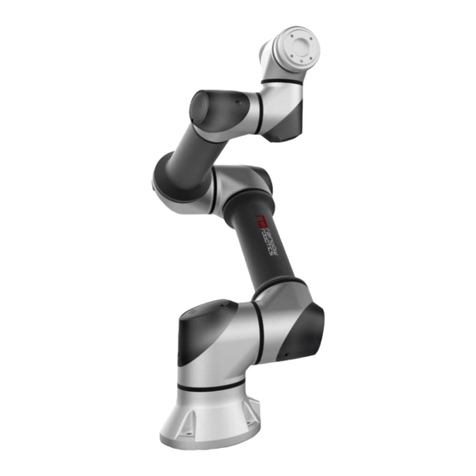
Rainbow Robotics
Rainbow Robotics RB Series user manual
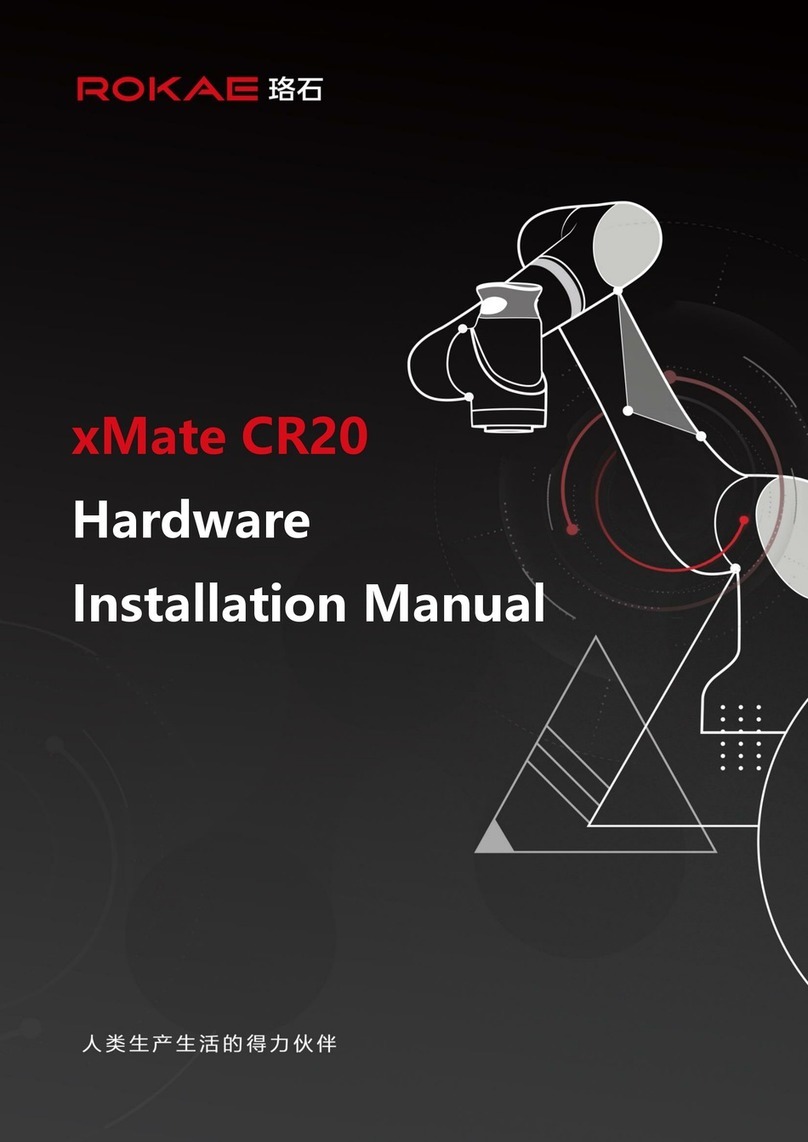
ROKAE
ROKAE xMate CR20 Hardware installation manual
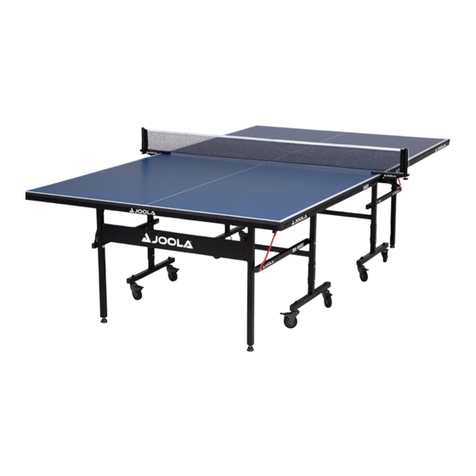
JOOLA
JOOLA INSIDE 15 instruction manual
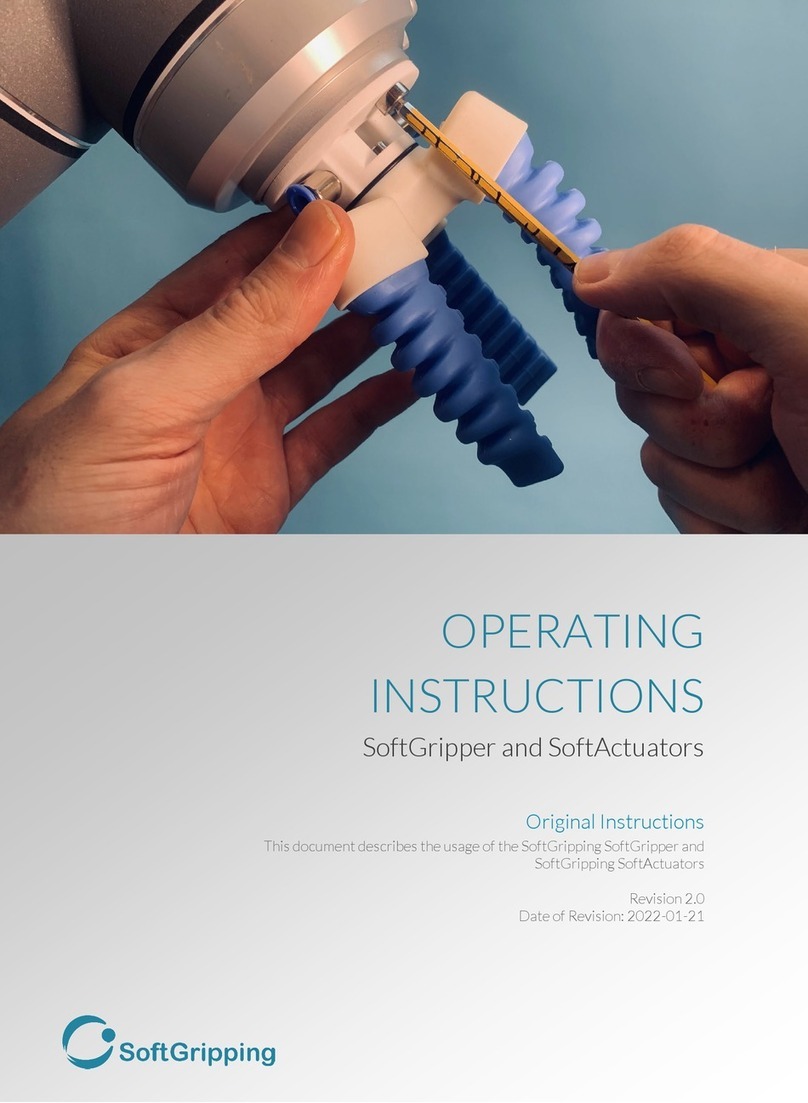
SoftGripping
SoftGripping SoftGripper operating instructions
LinkSprite
LinkSprite Rover ASSEMBLY AND PROGRAMMING MANUAL
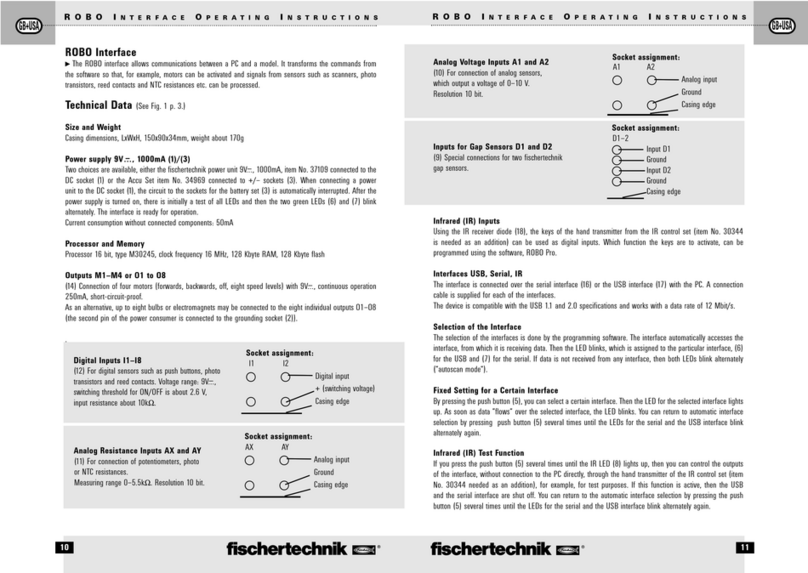
fischertechnik
fischertechnik ROBO operating instructions

